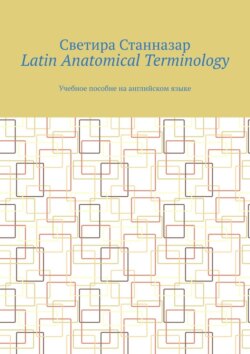Читать книгу Latin Anatomical Terminology. Учебное пособие на английском языке - - Страница 6
venosus, a, um – venous
ОглавлениеLexical Minimum of the 2nd Group Adjectives
NB! Adjectives of the 2st group are usually formed with the suffix -al-/-ar- with the meaning of relating to what the stem names.
arterialis, e – arterial
axialis, e – axial
capillaris, e – capillary
communis, e – common; general
dorsalis, e – dorsal, back
horizontalis, e – horizontal
jugularis, e – jugular
lacrimalis, e – lacrimal
lateralis, e – lateral, side
medialis, e – medial
mollis, e – soft
simplex, icis – simple
superficialis, e – superficial
teres, etis – round
ventralis, e – ventral
visceralis, e – visceral
Lexical Minimum of Adjectives with Meaning of Similarity
NB! These adjectives of Greek origin are formed with the Greek suffix -ide-, the adjectives of Latin origin are formed with the Latin suffix -form-.
Latin – English
Complex Adjectives
There is a number of ajectives formed by means of stems adding. A complex adjective is formed as follows: a final adjective is added to the initial stem of a noun using a connecting vowel o (a noun stem + o + an adjective): e.g. sternohyoideus, a, um; humeromuscularis, e.
Comparative Degree of Adjectives
NB! The dictionary form of adjectives in a comparative degree consists of 2 elements: the full form in masculine and feminine gender, the neuter ending: superior, ius. Other case and number endings are attached directly to the full form in masculine and feminine gender.
NB! In the Latin anatomical terminology, six comparative adjectives should be memorized:
superior, ius – superior (higher)
anterior, ius – anterior (front)
posterior, ius – posterior (back)
inferior, ius – inferior (lower)
major, jus – major (greater, larger)
minor, us – minor (smaller, less)
Superlative Degree of Adjectives
NB! The superlative adjectives are formed with the suffix -issim-/-rim- or by way of changing the stem. The dictionary form of adjectives in superlative degree shows their three generic endings: a full adjective form with a masculine ending, a feminine ending, a neuter ending: latissimus, a, um – widest, broadest. The stem is found by dropping the masculine ending.
Superlative Adjectives Used in Latin Anatomical Terminology
latissimus, a, um – the broadest, widest
longissimus, a, um – the longest
maximus, a, um – the greatest
minimus, a, um – the least
supremus, a, um – the highest
Prefixes of Adjectives in Latin Anatomical Terminology
(prefix – meaning – example)
circum- – around – circumflexus circumflex
ex (tra) – - external – extracellularis extracellular
inter- – between – intervertebralis intervertebral
in (tra) – - internal – intramuscularis intramuscular
infra-, sub-, hypo- – under – infraorbitalis infraorbital, sublingualis sublingual, hypoglossus hypoglossal
super-, supra-, epi- – above – supraclavicularis supraclavicular, epigastricus epigastric
re (tro) – - behind – retrosternalis retrosternal
pr (a) e-, ante- – in front of, before – praecaecalis prececal, antebrachium forearm
post- – behind, after – postnodalis postnodal
para- – near – paranasalis paranasal
peri- – around – perivascularis perivascular
semi- – half, one-sided – semilunaris semilunar
Names of Intestines
NB! Names of intestines represent substantive adjectives, i.e. adjectives that have passed into the category of nouns of declension II, the neuter gender, with the exception of two names: intestinum tenue; intestinum crassum.
intestinum, i n – intestine [bowel, gut]
caecum, i n – cecum [blind gut]
colon, i n – colon [middle gut]
duodenum, i n – duodenum [duodenal gut]
ileum, i n – ileum [twisted intestine]
jejunum, i n – jejunum [empty intestine]
intestinum tenue – small intestine [little gut]
intestinum crassum – large intestine [large gut]
rectum, i n – rectum
Names of Linings
NB! Names of linings represent substantive adjectives, i.e. adjectives that have passed into the category of nouns of declension I, the feminine gender, with the exception of three names: tunica muscularis; dura mater; pia mater.
tunica, ae f – coat, tunic, lining, membrane
tunica muscularis – muscular layer
arachnoidea, ae f – arachnoid
conjunctiva, ae f – conjunctive membrane
cornea, ae f – cornea
mater, tris f – mater [shell of the brain]
dura mater – dura mater
pia mater – pia mater
mucosa, ae f – mucosa, mucous membrane
Names of Teeth
dens caninus – canine tooth, cuspid
dens deciduus (lacteus, primarius, caducus) – milk tooth, baby tooth
dens incisivus – incisor
dens molaris – molar
dens permanens – permanent tooth, secondary tooth
dens praemolaris – premolar
dens serotinus [dens sapientiae] – wisdom tooth
Plural Number of Nouns and Adjectives
NB! For comparative adjectives, plural endings are attached directly to the full masculine and feminine form: superior, ius – superiores, superiora, superiorum; major, jus – majores, majora, majorum.
Lexical Minimum of Terms Always Used in Plural
NB! As an exception, the noun vas, vasis n, declension III, is declined according to the pattern of declension II in the Gen. plur. form: vasorum.
